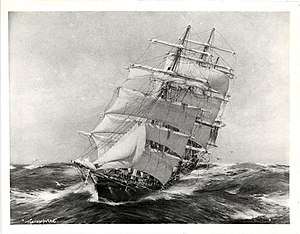Thermopylae (clipper)
Thermopylae was an extreme composite clipper ship built in 1868 by Walter Hood & Co of Aberdeen, to the design of Bernard Waymouth of London.[1]
 Thermopylae | |
| History | |
|---|---|
| Name: | Thermopylae |
| Builder: | Walter Hood & Co, Aberdeen |
| Launched: | 1868 |
| Notes: | Design of Bernard Waymouth, London |
| History | |
| Name: | Pedro Nunes or Pedro Nunez |
| Fate: | Torpedoed at sea, 13 October 1907, off Cascais |
| General characteristics | |
| Class and type: | Composite extreme clipper; naval training ship |
| Tonnage: | |
| Length: | 212 ft (64.6 m)[1] |
| Beam: | 36 ft (11.0 m)[1] |
| Depth: | 20.9 ft (6.4 m)[1] |
| Sail plan: | fully rigged ship[1] |

Construction

Thermopylae was built for the Aberdeen Line, which was founded in 1825 by George Thompson. She measured 212' × 36' × 20.9', with tonnage 991 GRT, 948 NRT and 927 tons under deck. The under deck coefficient was 0,58. Rigged with royal sails, single topgallant and split top-sails.
Records set in tea trade

Thermopylae was designed for the China tea trade, and set speed records on her maiden voyage to Melbourne—63 days, still the fastest trip under sail.
Race with Cutty Sark

In 1872, Thermopylae raced the clipper Cutty Sark from Shanghai back to London. Thermopylae won by seven days after Cutty Sark lost her rudder. From 1882 onward, Thermopylae took part in the Australian wool trade; however, on this route Cutty Sark proved faster.[2]
Naval training ship
In 1897 she was sold to Portugal for use as a naval training ship and renamed Pedro Nunes. On 13 October 1907, the Portuguese Navy towed her down the Tagus river using two warships, and before Amelia de Orleans, Queen of Portugal, she was torpedoed with full naval honours off Cascais.
References
- MacGregor, David R. (1983). The Tea Clippers, Their History and Development 1833-1875. Conway Maritime Press Limited. pp. 189–192. ISBN 0 85177 256 0.
- Carr, Frank G G, CBE, MA (December 1964) [December 1954], Cutty Sark, last of the clippers, The "Cutty Sark" Society, p. 4 – via reprinted from Yachting World
Further reading
- Day, Thomas Fleming (1919). Designs, Clipper Ship Thermopylae. Rudder. 35. New York: The Rudder Publishing Co. pp. 583–585. OCLC 1764636.
- Hume, Cyril L.; Armstrong, Malcolm C. The Cutty Sark and Thermopylae Era of Sail. Glasgow: Brown, Son & Ferguson, 1987 (hardcover, ISBN 0-85174-500-8).
- Matheson, Marny. Clippers for the record: The story of ship Thermopylae, S.S. Aberdeen, and Captain Charles Matheson. Melbourne: Spectrum, 1984 (ISBN 0-86786-051-0).
- Crosse, John; Thermopylae and the Age of Clippers. Historian Publishers, Vancouver.